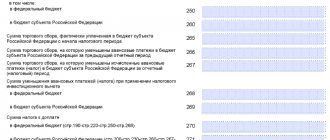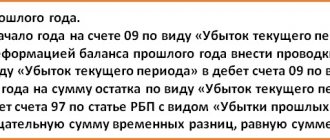How are balance sheet and income statement indicators related?
The financial reporting forms contain final indicators that characterize the financial results of the company as of the reporting date.
So, in the balance sheet it is line 1370 “Retained earnings (uncovered) loss”, and in the statement of financial results (Form No. 2) it is line 2400 “Net profit (loss)”, respectively. Despite the similarity, the rules for forming these values differ. Therefore, the amounts may not match. So, in line 1370 of the balance sheet you transfer the balance of account 84 “Retained earnings (uncovered loss)”, which is formed on an accrual basis from year to year since the beginning of the company’s activities. And the indicator on line 2400 of form N 2 must coincide with the amount of net profit (loss) for the reporting year. That is, in Form No. 2 you show the financial result of a particular year, it is equal to the final balance in account 99 “Profits and losses” for the year. It is this value that you then write off to account 84 when reforming the balance sheet.
To figure out whether in your particular case the amounts of profit (loss) in the balance sheet and form N 2 should coincide, let's look at how these values are formed.
Essence of the question. The indicator of line 1370 of the balance sheet and 2400 of form N 2 may not coincide. After all, the balance of account 84 is transferred to the balance sheet, which is formed by an accrual total for the entire existence of the organization. And in form N 2 only the financial result is shown - profit (loss) for the reporting year.
Procedure for filling out the financial results report
The form approved by the Ministry of Finance contains information for two years: the previous one (for which the document is prepared) and the year before (retrospective data from the last submitted FPR is transferred).
To obtain information for the period before last, you need to open a report compiled for the previous reporting date and copy the data from it line by line.
To fill out the latest information, the accountant will need to refer to accounting data, namely:
- SALT according to account 90, 91, 99;
- completed income tax return for the year;
- other analytical accounting information for the past 12 months available in the enterprise’s accounting program.
If the form is being prepared by an accountant for the first time, he should be guided by an example of filling out a statement of financial results, which can be found in the public domain.
If the accountant does not have the data to fill in certain lines, they are crossed out.
Important! The FRA is mandatory for preparation by all business entities, regardless of the volume and scope of activity. Small businesses have the right to fill out a document using a simplified form.
Situation No. 1. The amounts of profit (loss) in the balance sheet and form No. 2 are the same
So, in line 1370 of the balance sheet you show the sum of two values - the profit or loss that was at the beginning of the year, and the financial result for the year (account balance 99). While in form N 2 you show only the account balance 99.
When can the balance sheet and income statement be the same? This is possible if the profit that was reflected at the beginning of the year in account 84 was spent by the end of the year, that is, equal to zero. Then in both reporting forms you will show an account balance of 99.
Note! An accountant cannot decide for himself where to spend the company's profits. Such a decision must be made by the founders at the general meeting and documented in the form of minutes.
How can you spend profits from previous years, you ask? Only on the basis of the relevant decision of the founders. They can order to spend profits on the formation of reserve capital, payment of dividends, etc. In these cases, the corresponding amounts are written off from the credit of account 84. So, if the profit of previous years has been spent completely, the balance sheet and form N 2 indicators will coincide, since they will reflect only the profit of the current year.
Another option is that the indicators in lines 1370 of the balance sheet and 2400 of the report will be equal if at the beginning of the reporting year you had no profit (loss) from previous years on account 84.
What does line 1370 of the balance sheet consist of?
The line codes in the accounting reporting forms are given in Appendix No. 4 to Order of the Ministry of Finance dated July 2, 2010 No. 66n. Thus, line 1370 is called “Retained earnings (uncovered loss).” As the name suggests, this line reflects the amount of retained earnings or uncovered losses accumulated as of the reporting date.
In accordance with the Chart of Accounts and the Instructions for its use, account 84 “Retained earnings (uncovered loss)” is provided for accounting for retained earnings (uncovered loss).
However, this account only reflects the profit or loss accumulated at the end of the year, i.e., December 31st. If the balance is drawn up as of the interim reporting date, to fill out line 1370, the balance of not only account 84, but also account 99 “Profits and losses” is used. Let us recall that it is in account 99 that profits or losses from ordinary activities, other operations, as well as amounts directly attributed to account 99 (for example, fines for violation of tax laws) are accumulated throughout the year.
If a loss is reflected on line 1370 on the reporting date, then its amount is shown not with a minus, but in parentheses, for example: (10,000).
Please also note that interim dividends paid during the reporting year are shown in the balance sheet separately in parentheses on a separate line in Section III of the balance sheet (Letter of the Ministry of Finance dated December 19, 2006 No. 07-05-06/302). For example, on line 1371 “including interim dividends”.
Let's give an example. As of December 31, 2017, the credit balance of account 84 is 365,000 rubles. At the same time, interim dividends in the amount of 29,000 rubles were paid during the year, which corresponded to the accounting entry of the form: Debit account 84 – Credit account 75 “Settlements with founders” (Order of the Ministry of Finance dated October 31, 2000 No. 94n). Therefore, in the balance sheet at the end of 2021, profit and its use for the payment of interim dividends will be reflected as follows:
Line 1370 “Retained earnings (uncovered loss)”: 365,000
Line 1371 “incl. interim dividends": (29,000)
“Simplified”, 2015, N 2
The financial reporting forms contain final indicators that characterize the financial results of the company as of the reporting date. So, in the balance sheet it is line 1370 “Retained earnings (uncovered) loss”, and in the statement of financial results (Form No. 2) it is line 2400 “Net profit (loss)”, respectively. Despite the similarity, the rules for forming these values differ. Therefore, the amounts may not match.
So, in line 1370 of the balance sheet you transfer the balance of account 84 “Retained earnings (uncovered loss)”, which is formed on an accrual basis from year to year since the beginning of the company’s activities. And the indicator on line 2400 of form N 2 must coincide with the amount of net profit (loss) for the reporting year. That is, in Form No. 2 you show the financial result of a particular year, it is equal to the final balance in account 99 “Profits and losses” for the year. It is this value that you then write off to account 84 when reforming the balance sheet.
To figure out whether in your particular case the amounts of profit (loss) in the balance sheet and form N 2 should coincide, let's look at how these values are formed.
Essence of the question. The indicator of line 1370 of the balance sheet and 2400 of form N 2 may not coincide. After all, the balance of account 84 is transferred to the balance sheet, which is formed by an accrual total for the entire existence of the organization. And in form N 2 only the financial result is shown - profit (loss) for the reporting year.
Turnover of Signal LLC for 2014 according to account 84
| Operation | Sum | Wiring |
| Accumulated profit of previous years as of January 1, 2014 | 25,000 rub. | Credit balance on account 84 at the beginning of the year |
| Dividends paid for 2013 | 10,000 rub. | Debit 84 Credit 75 |
| Interim dividends for 2014 were paid. | 5000 rub. | Debit 84 Credit 75 |
| The profit received at the end of 2014 was written off. | 30,000 rub. | Debit 99, sub-account “Profit of the current year”, Credit 84, sub-account “Retained earnings (uncovered loss)” |
The balance of account 84 as of December 31, 2014 is:
40,000 rub. .
In line 1370 of the balance sheet, the accountant recorded the amount of 40,000 rubles. And in line 2400 of form N 2 - 30,000 rubles. — the amount of the debit balance at the end of the year for account 99, subaccount “Profit (loss) of the current year.” It was this amount that on December 31, 2014, he transferred to the credit of account 84 when reforming the balance sheet.
Situation No. 2. The amounts of profit (loss) in accounting forms differ
In most cases, the final financial result of the balance sheet and the final financial result of Form N 2 will not coincide. For example, if your company made a loss last year, you will reduce the current year’s profit by that amount. Or increase the size of the current loss. Thus, here the account balance of 84 at the end of the year and the account turnover of 99 cannot possibly coincide. Let’s say that in 2013 the company had a loss of 10,000 rubles. (debit balance on account 84). And for 2014 the profit was 12,000 rubles. (balance on the debit of account 99, subaccount “Profit (loss) of the current year”). The final balance on account 84 credit for 2014 will be equal to 2000 rubles. (12,000 rubles - 10,000 rubles).
V.V. Zoreva
Expert of the magazine "Simplified"
What's happened?
The Federal Tax Service of Russia published a letter dated July 31, 2021 No. BA-4-1/ [email protected] , in which it informed all taxpayer organizations, as well as its territorial authorities:
- recommended machine-readable forms of financial statements, including simplified ones, which are subject to submission to the tax authorities for the reporting year 2021;
- control ratios necessary to verify the financial statements provided.
Amendments to the reporting forms and control ratios were made in connection with the adopted amendments to the Federal Law of December 6, 2011 No. 402-FZ “On Accounting”.
New balance sheet and other reporting forms
Starting from 2021, the Federal Tax Service of Russia is obliged to create and maintain a state information resource for accounting (financial) reporting. Therefore, organizations have been relieved of the obligation to submit a legal copy of their financial statements for 2021 and beyond to the statistical authorities. You only need to report to the Federal Tax Service at your place of registration. It was established that:
- small businesses submit reports on paper or in the form of an electronic document;
- all other economic entities submit reports in the form of an electronic document.
That is why the forms have been brought into compliance with the new requirements. The most changes were made to Form No. 2 “Report on Financial Results”, in particular, it changed:
- Name,
- line numbers,
- composition of the indicator “Income tax”.
Current forms of accounting (financial) statements are posted on the websites of the Federal Tax Service of Russia and JSC GNIVC. They should be applied starting with reporting for the current year.
What is indicated in line 2310?
Instructions for filling out a statement of financial results state that this line is intended to reflect income from participation in other commercial entities. Such income includes:
- dividend payments in favor of company participants;
- receipts of property or cash after the closure of business structures, the capital of which (in whole or in part) belonged to the company.
Current instructions stipulate that dividends should be taken into account minus personal income tax, which was sent to the budget by the company that paid the income.
Important! If participation in the capital of other legal entities is the main direction of the company’s work, income from it is reflected on line 2110, and in 2310 a dash is added.
To find the amount to indicate in the line, you need to take the amount collected in the debit of the account. 91 for a subaccount intended to reflect income from contributions to the authorized capital of other legal entities.
New control ratios for balance, form No. 2 and form No. 3
The control ratios in form No. 2 for the line “Net profit” have changed. Now the indicator “Net profit or loss” of the balance sheet on line 2400 of column 4, 5 should be equal to the sum of lines 2300 “Profit (loss) before tax”, 2410 “Income tax” and 2460 “Other” in columns 4, 5, respectively. If an indicator for a line is in parentheses, then a minus sign (-) is placed in front of it.
The indicator “Cumulative financial result of the period” reflected in line 2500 of columns 4, 5 should be equal to the sum of lines 2400 “Net profit (loss)”, 2510 “Result from the revaluation of non-current assets not included in the net profit (loss) of the period”, 2520 “Result from other operations not included in the net profit (loss) of the period” and 2530 “Profit tax from operations, the result of which is not included in the net profit (loss) of the period”, columns 4, 5, respectively. The rule for reflecting a negative indicator in parentheses also applies to it.
These and other control ratios in the letter of the Federal Tax Service are traditionally shown in the table. It indicates the names of the reporting forms, the control ratios themselves, the possible errors they indicate, and the actions of the inspectors when identifying a discrepancy. Practical recommendations are also given. In particular, it is indicated how to calculate the increase or decrease in capital for the previous year in the “Statement of Changes in Capital”. The rules for calculating cash flows from current operations in the “Cash Flow Report” and the amount of funds received in the “Report on the Purposeful Use of Funds” are also defined.
Page 2400 income statement
This is the logical result of drawing up a report - indicating the amount of net profit (loss) received by the company for the period. To get the required number, the accountant needs:
- reduce line 2300 by the amount of accrued income tax
- then add positive values pp. 2430-2460 or subtract negative ones.
If the result is positive, the company made a profit, if negative, the operation in the past period brought losses. This value is indicated in parentheses.
Question:
We prepare a balance sheet and Form 2 “Profit and Loss Statement” for the 1st half of 2021. Accountants tell us that the line “retained earnings” in the balance sheet should converge with the similar line 2400 in Form 2, but it diverges by 8 thousand. If you look at the balance sheet, then the balance of account 99.01.1 clearly appears in the balance sheet, but in form 2, line 2400 is calculated using formulas and collected from different accounts. And here the question arises: should these lines converge? And for any period, maybe they will coincide at the end of the year, when there will be reporting for the whole year and there will be a reformation of the balance sheet?
Our opinion:
The relationship between the indicators of the Balance Sheet and the Profit and Loss Statement is observed under the following conditions:
Please note that the indicators are interrelated (equal) if during the reporting period there was no turnover on account 84 (with the exception of balance sheet reformation). For example, no dividends were accrued and no contributions were made to reserve capital. If the balance of retained earnings was used in the reporting period, then the amount of profit used should be a discrepancy between lines 1370 of the Balance Sheet and 2400 of the Income Statement.
The procedure for filling out the Balance Sheet and the Profit and Loss Statement when preparing interim reporting has the following features:
The procedure for filling out the Balance Sheet and the Profit and Loss Statement when preparing annual reports:
Line 2120 of the income statement
According to the indicated line, the company or individual entrepreneur reflects the cost, i.e. the amount of expenses for core activities included in the final price of manufactured products, services provided, etc.
The cost includes expenses for the purchase of goods for resale, for the production of own products, performance of work, preparation of real estate for rental, if this area is recognized as the main one for the business entity, etc.
To fill out this line of the financial results statement, it is accepted as a rule that expenses are determined based on the price of the contract with the supplier (contractor), reduced by the totality of the discounts provided.
According to PBU 10/99, expenses are recognized according to the following rules:
- They are taken into account in connection with the receipt of income.
- If expenses determine the receipts of several periods, the accountant needs to reasonably break them down.
- For companies maintaining simplified accounting, the date of debt repayment is recognized as the moment of recognition of expenses.
Line 2120 of the financial results report is equal to the amount of turnover in the debit of the account. 90 in correspondence with cost accounts (20, 23, 29, 41, etc.). The accountant does not need to take into account the amounts corresponding to the account. 16 and 44. Other lines of the form are provided for them.
Costs for various areas of core activity, amounting to more than 5% of the total value, are broken down into separate lines of the general financial structure. For example, an accountant highlights the value for the production of products, the provision of intermediary services, the preparation of offices for renting, etc.
Conclusion:
Comparability of indicators in lines 1370 “Retained earnings (uncovered loss)” of the Balance Sheet and 2400 “Net profit (loss)” of the Financial Results Report must be observed in any reporting period, if during this reporting period there was no turnover on account 84 (except for reformation balance). If the balance of retained earnings was used in the reporting period, then the amount of profit used should be a discrepancy between lines 1370 of the Balance Sheet and 2400 of the Income Statement.
Line 2110 of the income statement: contents
The indicated line of the form reflects the revenue of the company or individual entrepreneur for two periods: last year and the year before last. Current legislation classifies the following categories into this concept:
- income from the sale of self-made products and purchased products;
- funds received from the performance of work, provision of services within the framework of the company’s main activities;
- rent if the company specializes in renting out real estate;
- license fees (if the main direction of the company is providing third parties with rights of use);
- other income from the main area of work.
Filling out a statement of financial results line by line involves preliminary calculation of indicators in compliance with established accounting rules. For revenue, they are prescribed in PBU9/99 (Article 12). Failure to meet any of the criteria means that the accountant does not have the right to classify specific receipts as income.
To calculate revenue, the contract price adjusted to the amount of all discounts provided to the client is taken as the basis. The finished figure is “cleared” of VAT.
Line 2110 of the income statement is equal to the difference between:
- turnover on the loan account. 90 (sub-account “Revenue”);
- the amount of VAT and excise taxes “wired” into income (collected in the debit of account 90 in the corresponding sub-accounts).
For different types of revenue that make up 5% or more in its total structure, the accountant enters separate lines in the financial reporting structure. For example, he can split the total indicator into income from the sale of finished products, purchased goods, provision of agency services, etc.
Selling expenses in the income statement









